Dutch Hans Weilenmann tells the history of the use of CDC feathers in fly tying, covers the different types of feathers and their use and lists both CDC tying tips and a bunch of CDC patterns.
Many birds preen, recondition, and waterproof their feathers with an oil secreted from their preen (uropygial) glands. CDC feathers sit on top of the gland and the area close around it. While CDC is normally harvested from members of the duck family ("canard" is the French word for duck), other waterfowl such as geese offer similar quality feathers. As the size of the bird increases, so will the size of the feathers.
The description "Cul de Canard" was reputedly coined in the late 1950s by French tier Henry Bresson for one of his patterns. The description has contributed to some confusion, especially when it was literally translated into English as "duck's butt" or "duck's arse" feathers. In fact, the preen gland is located on the back of the bird, a short distance up from where the tail feathers sprout from the skin.
History
CDC's history in fly tying and fly fishing begins in central Western Europe in the 1920s and the dry flies used by fishermen living in the Swiss Jura Mountains near the French border. These patterns, generally referred to as Moustique patterns, remained unchanged until well into the late 1970s. A generic Moustique pattern features a cock-hackle tail, a slender body of wrapped raffia or thread (later the patterns were tied with silk floss) ribbed with contrasting color silk thread, and a CDC collar.
In the 1980s similar flies continued to be tied and fished across Western Europe. Sometimes tiers would omit the tail, but they retained the CDC collar and at times combined it with a second material such as cock hackle.
Note: Marc Petitjean, a CDC aficionado and one of the key people in modern development of CDC flies, conducted much of the research into the early use of CDC. His research and that of other angling historians and tiers as well as over 100 CDC patterns from several continents has been published in Tying Flies with CDC: The Fisherman's Miracle Feather by Leon Links (Melwin Unwin, 2002).
In 1980, Marjan Fratnik, a tier from Slovenia, designed the F Fly. This simple, elegant, and deadly fly was a radical departure from how CDC was used. For this caddis imitation, Fratnik stacked two or three CDC feathers and tied them in at the eye of a thread-covered hook shank with the feather tips facing over the bend. He then trimmed the feather stems short at the eye of the hook and trimmed the wing length to the proportions and angle he desired. The F Fly triggered renewed interest in a growing number of European tiers for other uses for CDC.
The versatility of CDC
|
|
|
|
|
|
|
|
|
|
|
|
Between 1985 and 1988, Gerhard Laible wrote a series of articles on a range of techniques and patterns using CDC in the German fly-fishing publication Der Fliegenfischer. Laible complemented his articles with the first book focusing solely on this material, CDC Flies, published in Germany in 1993.
Dutch tier Hans van Klinken (originator of the Klinkhamer Special) turned CDC upright with his Once & Away pattern in 1988. The Once & Away has since spawned a host of patterns, generally referred to as Shuttlecock flies, which continue to be popular in Western Europe, especially with stillwater anglers. Shuttlecock designs are excellent ascending midge patterns for lakes and tailwaters.
While many European tiers contributed to the development of CDC techniques, Fratnik, Laible, and van Klinken rank as prominent firsts. Another European tier I rank in this small group is Marc Petitjean, from Switzerland, who is perhaps the best-known proponent of CDC techniques and patterns today. Some of the techniques he either originated or at least made known to a wider audience are the use of a full CDC feather rolled into a noodle, tied in by the tip, twisted and wrapped as a naturally tapered body (1985), his elegant and innovative use of CDC to make split wings, and in 1992 the mental leap to incorporate CDC in subsurface patterns. Since then the range of Petitjean's patterns has expanded to cover terrestrials, leeches, crustaceans, salmon and steelhead flies, and saltwater patterns.
By the late 1980s the first signs of CDC in North American contemporary fly tying became visible. In 1994 the English version of a French book by Jean-Paul Pequegnot French Fishing Flies appeared as the first book on the American market, with references to CDC and CDC flies. It was followed by Darrel Martin's Fly-Tying Methods (1987), which devotes a half page to CDC, and Micropatterns (1994), in which a section on CDC provides the first in-depth description of its properties. The book lists over a dozen patterns incorporating CDC, an indication of its growing popularity among tiers.
René Harrop's landmark article in the July 1991 issue of Fly Fisherman put him at the forefront of North American CDC proponents and helped popularize CDC in the States. A second prominent North American tier who has been developing techniques and patterns using CDC is Colorado tier Shane Stalcup. Between them, they have come up with a number of imaginative and effective patterns.
Understanding CDC
While the natural oils on the feather assist in repelling water, the hydrophobic properties and the structure of the CDC feather are fundamental to its floatability.
Feathers are completely made up of the protein keratin. They are built to be as light as possible in order to make the bird fly easily, yet are extremely strong and waterproof at the same time. Keratin in many ways resembles manmade plastic. One aspect is that it does not soak up moisture, or indeed oil. The oil can only coat the feather parts, not become an internal part of it.
If it was solely the oil in the feather that makes it float, dyeing CDC would prevent the feather from floating, but this is not the case--provided the dye job keeps the feather's structure intact.
Furthermore, CDC feathers don't float at all when they are matted with water or fish slime. If the oil was the primary contributor to the feather's buoyancy, the collapse of the structure wouldn't matter greatly, but waterlogged or slimed up CDC patterns are known to sink like a stone!
If you can maintain the feather's structure, the surface area of the barbules in the film works to keep the fly afloat and the tiny air bubbles retained in the ribbon-like, kinked structure of the hydrophobic barbules hold up those barbs that have broken through the surface film.
A closer look at the makeup of a CDC feather shows why applying a liquid or paste floatant collapses the feather structure and ruins the characteristics of the feather that help it float.
1. A CDC Feather
2. Zooming in on the CDC feather structure the stem shows, besides the barbs, jagged protrusions. The barbs in turn sport ribbon-like twisted barbules. Flattened barbules maximize the surface area. In the surface film, a larger and water repellant surface area assists floatation of the dry CDC pattern.
3. Zooming in even more, this illustration shows a submerged CDC feather. The ribbon-like and twisted barbules retain tiny bubbles of air which adds buoyancy to the CDC.
The primary quality of CDC for me is the mobility of the barbs, whether moving in the air currents above the water's surface or moving in the water currents in the film or subsurface. CDC wings positioned above the surface film do not contribute to buoyancy, but do offer a full silhouette without the bulk, and respond to the slightest breeze to suggest life. Submerged, the mobile CDC barbs likewise respond to every shift in current, again suggesting life.
Both natural and dyed CDC imparts a built-in life to flies. This is where CDC shines and this is what makes CDC an excellent choice to feature in a broad range of patterns. CDC also blends in well with other materials, where the combinations of their respective properties complement one another to make for a more effective result.
With correct use of the material and treatment on the stream CDC flies are among the most durable of patterns as well as some of the simplest patterns to tie.
CDC Types
While CDC feathers are generally lumped together under the single umbrella called CDC, examining the feathers shows distinct difference in their appearance depending on where they are found in relation to the gland. Certain types of feathers are more suitable for specific purposes.
I use a simple classification system I designed to explain to other tiers the types of CDC most desirable for different patterns or functions. I categorize CDC into four distinct types:
Type 1:
This feather resembles a partridge body feather. The feather has a rounded tip and a fairly short, tapered stem with barbs set at approximately 60 degrees from the stem.
I wrap this feather around the shank to produce body and trailing filaments for the CDC & Elk.
Type 2:
This feather has a thin stem and the barbs run mostly parallel to the stem, ending in a square, brush-like tip.
These feathers are good for wings including wing posts and loop wings in patterns such as the Snowflake Dun (Roman Moser), the CDC Micro Caddis (Ronald Leyzen), the CDC No-hackle, and the CDC Loop Wing Emerger.
Type 3:
The nipple plume, sometimes referred to as oiler puff. This short feather lacks a discernable stem but looks broadly similar to a Type 2 feather.
This feather is ideal for tails, trailing shucks, and emerging wings for such patterns as the Snowflake Dun, the Balloon Emerger (Roman Moser), and various RS 2-type flies.
Type 4:
This feather has a long stem with relatively short barbs. Shop-bought bulk packages mostly hold Type 4 feathers. I use these feathers to tie IOBO Humpy patterns and to wrap the body on large hook size versions of the CDC & Elk, such as in the CDC & Elk Streamer or the Bonefish CDC & Elk (Paul Slaney). Rene Harrop uses Type 4 feathers for downwing flies such as his CDC Transitional Caddis.
Harvesting CDC
The best quality CDC comes straight off the bird. The harvesting process is simple and swift and the average mature bird provides between 70 and 100 usable feathers.
Once you lift the cover feathers, you can easily locate the preen gland by feel as well as sight. The visible part of the gland shows up like a shiny pebble protruding from the surrounding skin and is capped by a clump of feather puffs (Type 3 feathers, or oiler puffs) saturated with oil. On the illustration these feathers are shaded darker and are just below the thumbnail. The larger feathers surround the gland and increase in size as they get farther away from the center. On a mature mallard the stem on the longest feathers that still retain the CDC structure may be close to 2 inches long. On a goose they may exceed 3 inches.
For those who hunt or have friends that hunt ducks, or for those interested in where the CDC feathers are located on the bird, this drawing depicts the exact location of the CDC feathers.
Store the saturated oiler puffs with the rest of the feathers and in a few days the oil will have dispersed evenly across the feathers, leaving the oiler puffs fluffy.
Fresh CDC feathers are mostly free from vermin, but to be safe put the container with feathers in the freezer for a couple days to kill any mature bugs. This may leave some eggs intact, so remove the container from the freezer for a day or two to allow any surviving eggs to hatch, then put it back into the freezer for a couple days to finish the process.
Tips and Tricks With CDC
Bleaching: Bleaching natural dun-colored CDC feathers in a mixture of equal amounts of 3 percent hydrogen peroxide and household ammonia results in a wonderful warm light-amber color. The timing is not critical and may range from several hours to an overnight soak. Rinse the feathers in fresh water and let them air-dry. The resultant feather stem remains pliant, and the bleaching process appears to leave the feather structure mostly intact. The hydrogen peroxide and ammonia mixture gives off unpleasant and unhealthy fumes, so make sure the area is well ventilated.
Dubbing: Barbules broken away from the stem make nice dubbing material. Use them alone or mix in other natural fur or synthetic dubbing.
Bodies: Roll a Type 2 feather on a sheet of firm foam. Press the feather down with your fingertips and roll perpendicular to the stem. Start from the butt and work up toward the tip. Once you form the "rope" you can tie it in by the tip and wrap it around the shank for a buoyant and naturally tapered body. Many of Marc Petitjean's patterns feature this style of body. Including the stem makes these bodies virtually bulletproof, without the need of a reinforcing rib.
Trimming: When you cut CDC with scissors, you get an unnatural looking square edge. "Tear away" the excess length of the barbules for ends resembling the natural tips.
Drying: I prefer to dry my CDC patterns using amadou. I have experimented with other drying agents such as Shimazaki Dry Shake and Frog's Fanny, but it appears that once you use either of the two on a pattern, the buoyancy only lasts one fish before the drying agents need to be reapplied. Flies dried with amadou can be fluffed up by blowing air on them, or with several false casts.
CDC & Elk
Every fly fisherman has to believe in something. For me enticing fish to take a fly hinges on the concept of triggers. Offer a fish the appropriate positive triggers and it is more likely to think "food!"
Based on this philosophy, I designed the CDC & Elk in 1992, and it has become my staple dry fly. In this pattern, I combine the proven wing silhouette and buoyancy of Al Troth's Elk-hair Caddis with the lifelike qualities of a Type 1 CDC feather wrapped around the hook shank. The CDC dubbing on the body and the straggling filaments suggest anything from sprawling insect legs, to trailing nymphal shucks, to crippled wings.
Over the past decade, the CDC & Elk has taken fish consistently on many waters and several continents. It is a pattern deceptive in its simplicity and versatility. From its beginning as a modified Elk-hair Caddis it slipped into the slot as my go-to fly for a multitude of mayfly hatches, a general search pattern to cover hatchless periods, an emerger pattern, and a wet fly.
Select a properly sized (Type 1) CDC feather. The longest barb should be approximately two times the hook shank length.
Hold the butt of the CDC feather with the fingers/thumb of your left hand, and draw the feather between thumb and index finger of your right hand toward the tip, bunching the tips together.
Tie in the bunch, butt pointing backwards over the hook bend. Tie the feather down with two tight turns of thread, then slip a third turn under the tips to force them upward and follow with a fourth turn over the tips, just forward of the third turn to lock the CDC barbs in place. Spiral-wrap the thread forward to eye, then wrap back one touching turn away from the hook eye.
Clamp the feather butt with hackle pliers and wind the CDC feather toward the eye in touching turns. The rear half of the body resembles a dubbed body, but as you progress toward the eye more and more free barbs will stand out. Stroke these back with each turn. With a little practice, you will learn to arrive at the hook eye with only the bare part of the stem left.
Tie off the CDC feather with one or two tight turns of thread and unclip the hackle. Do not trim yet. Tighten with another two turns of thread. The CDC butt will move with the thread, tightening further at the tie-off point. Trim the CDC butt.
Take a small amount of straight, fine-tipped deer hair. Even the hair tips in a stacker. Position the bunch of hair on top of the hook parallel to the hook shank. Measure the tips so the wing will be just long enough to just reach the back of the hook.
Trim the butts square (perpendicular to the strands) with the front of the hook eye prior to tying in the wing.
Tie down the wing with two tight wraps of thread over the hair stubs. Make a third wrap with the thread, through the stubs, at a 45 degree angle. Fourth wrap goes under the stubs. Complete the fly with a whip-finish under the stubs and a little varnish. Aim for a neatly rounded head.
I use early season mule deer for the wing on the CDC&Elk. Select your hair to show the following characteristics:
- Uniform length, i.e. even tips.
- Minimal amount of underfur.
- Relatively short overall length of hair (no more than twice the length of the section used for the wing).
- Straight, not curved, hair to stack easily (some tiers prefer uneven look, I generally stack my wings).
- Slight_ crinkle in the lower half of the hair is a good indicator of a choice piece of mule deer hair!
- Finely pointed, undamaged tips.
- Fairly steep taper to the hair, which allows me to produce the distinct, rounded head on the CDC&Elk.
- Distinct coloration of the tip section. I like a dark tip, with a lighter colored band further down.
The hair used for the CDC&Elk (and other Elk Hair Caddis derived patterns) should exhibit a controlled amount of flare when the wing is tied down, though not as much as hair used for Comparadun style patterns.
To check the flaring behaviour of a piece of deer hair I generally employ the following test:
Lift up a wing-quantity of hair with the pad of index finger, with the tie-in point of the hair centered on the finger.
Pinch into this hair with the edge of the thumbnail, pressing down into the index finger pad.
Select hair on the amount of flare observed
A 5 minute movie on tying the CDC&Elk is available here:
- Log in to post comments

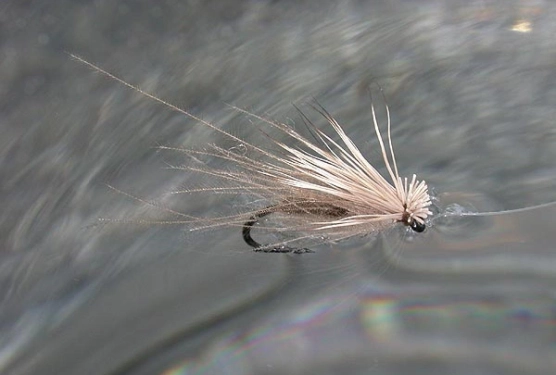
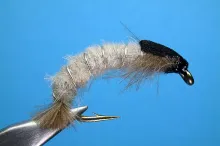

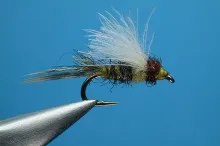
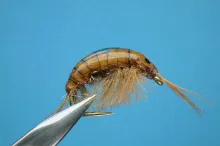
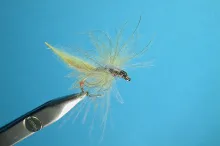
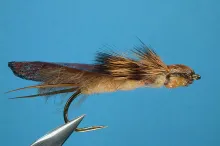
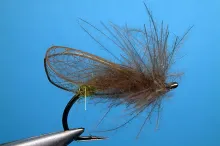
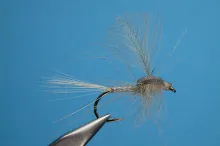
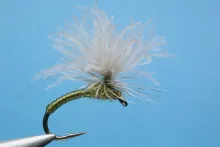
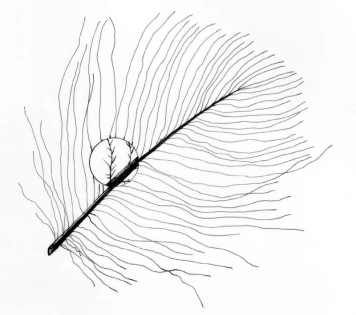
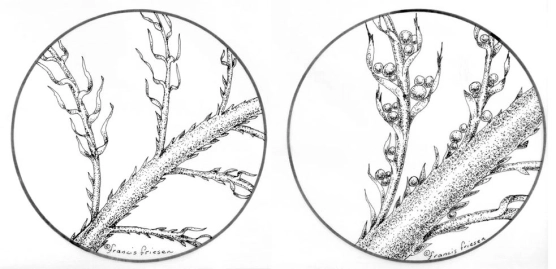
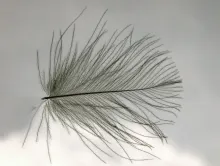
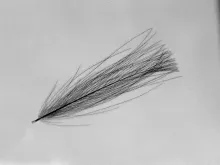
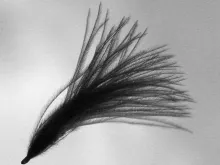
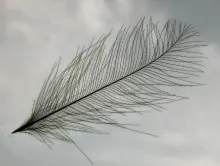

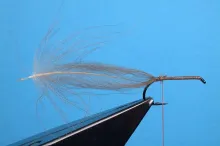
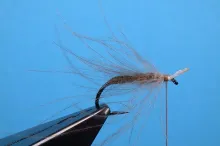
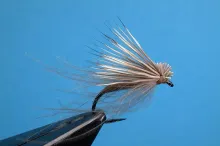
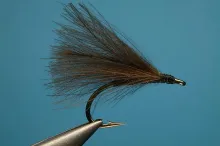
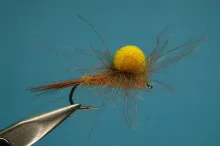
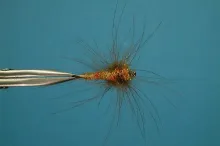
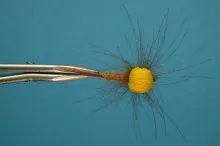
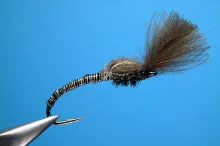
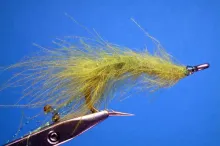
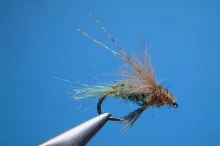
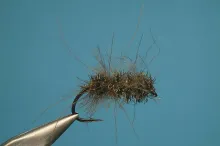
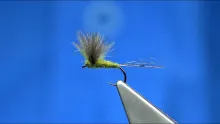

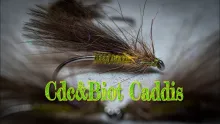
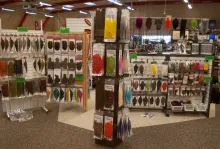
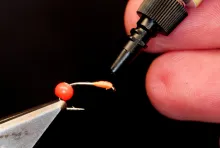
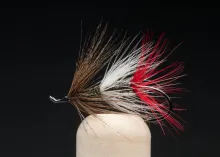

Hans, great article,
Hans, great article, great flies !!! Only one remark. There is still one disadvantage when tying with cdc. CDC flies are vulnerable and they remain not dry. Lucky there is amadou.
No gel or grease really works. Kind regards, Ad
Hans - I read your a
Hans - I read your account of CDC with great interest - noting particularly the portion on understanding the properties of CDC as it closely paraphrases some American Angler articles predating your entry here by six years; articles that somehow escaped mention in your otherwise extensive literature search on the subject - right down to mention of the effects of floatant on CDC and the ability of the feather barbules to capture air bubbles - both photographically illustrated in the AA pieces.
I have to agree with
I have to agree with all others ... Hans, a very good article. The only one you need if you intent to tie with CDC
Nice looking flies!
Nice looking flies! I liked it a lot but I have not had the chance to try it out as yet.
Very helpful.
I lov
Very helpful.
I love CDC and I am looking for more patterns and styles of CDC flies.
Thanks
Great page! Few arti
Great page! Few articles of this length contain SO MUCH useful information.
Very useful article!
Very useful article!
I have to agree with
I have to agree with Donald, very good article and very comprehensive
A great article Hans
A great article Hans, this is probably the best info on CDC to date. I really enjoyed the article and the pictures
are excellent. Keep up the good work.
drying/re-floating CDC
A friend of mine discovered this trick--Kleenex!! Yes-- wipe down a fish slimed cdc fly thoroughly with a small wad of Kleenex.it will float like a cork! Do NOT ever use liquid flotants OR dry desiccants. dry cdc doesn't need it.